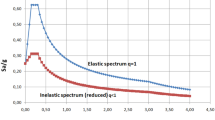Abstract
Lateral load is believed to be acted at the centre of mass (CM) of elevated water tank whenever ground motion takes place. Lateral load induces axial force and horizontal shear force in all the columns and vertical shear force in all the braces of the tank staging which are associated with rigid link mechanism between CM and top nodal points of the staging frame. These forces in turn develop column moment and beam moments. Lateral load analysis and staging stiffness of elevated water tanks were found by earlier investigators through analytical methods of those having approximations. The present study aims at proposing a more realistic and simple analytical method to determine stiffness and member force owing to lateral load for any given configuration of elevated tank. The nodal displacements obtained from the proposed method were in line with existing methods. Furthermore, this study attempts to carry detailed analysis of tank staging configuration which consists of columns arranged in two concentric circles. The results of the lateral load analysis show that size of the radial beam has significant influence on the responses of the tank staging.

















Similar content being viewed by others
References
Argyris, J. H. (1964). Recent advances in matrix methods of structural analysis. New York: Macmillan Co.
BIS. (1982). SP: 22–1982, Explanatory hand book on codes for earth quake engineering IS: 1893–1975 and IS: 4326–1976. New Delhi: BIS.
Balendra, T. (2013). Vibration of buildings to wind and earthquake loads. Berlin: Springer.
Bureau of Indian Standards. (2016). Indian Standard Code 1893 (Part 1): Indian standard criteria for earthquake resistant design of structures. New Delhi: Bureau of Indian Standards.
Chan, C. M., Huang, M. F. & Kwok, K. C. S. (2009). Stiffness optimization for wind-induced dynamic serviceability design of tall building. Journal of Structural Engineering, 135(8), 985–997. https://doi.org/10.1061/(ASCE)ST.1943-541X.0000036.
Dutta, S., Jain, S., & Murty, C. (2000a). Assessing the seismic torsional vulnerability of elevated tanks with RC frame-type staging. Soil Dynamics and Earthquake Engineering,19, 183–197.
Dutta, S., Jain, S., & Murty, C. (2000b). Alternate tank staging configurations with reduced torsional vulnerability. Soil Dynamics and Earthquake Engineering,19(3), 199–215. https://doi.org/10.1016/S0267-7261(00)00004-X.
Fialko, S. (2017). Application of rigid links in structural design models. International Journal for Computational Civil and Structural Engineering,13, 119–137.
Indian Standard Code (2000) : IS 456:2000. (2000). Plain and Reinforced Concrete Code of Practice. Indian Standard, p 107.
Jain, S. K., & Sameer U. S. (1990) Seismic design of frame stagings for elevated water tank: Ninth symposium on earthquake engineering, vol. 1, (pp. 113–120).
Krishna, J., & Sekharan, C. (2014). Elements of earth quake engineering. New Delhi: Standard Publisher Distributer.
Mathew, G., & Jangid, R. (2018). Seismic response control of a building by negative stiffness devices. Asian Journal of Civil Engineering,19, 849–866.
Rai, D. (2002). Seismic retrofitting of R/C shaft support of elevated tanks. Earthquake Spectra,18, 745–760.
Rai, D. C. (2003). Performance of elevated tanks in Mw 77 Bhuj earthquake of January 26th, 2001. International Journal of Advanced Engineering Research,112(3), 421–429.
STAAD Pro v8i. (2012). SELECT series 4 user manual
Sajjad, S., & Jain, S. (1994). Lateral-load analysis of frame stagings for elevated water tanks. Journal of Structural Engineering,120, 1375–1394.
Sameer, U. S., & Jain, S. K. (1992). Approximate methods for determination of time period of water tank stagings. The Indian Concrete Journal,3, 691–698.
Soroushnia, S., Tafreshi, S., Omidinasab, F., Beheshtian, N., & Soroushnia, S. (2011). Seismic performance of RC elevated water tanks with frame staging and exhibition damage pattern. Procedia Engineering,14, 3076–3087.
Titiksh, A. (2018). Parametric study on cylindrical water tanks by varying their aspect ratios. Asian Journal of Civil Engineering,20, 187–196.
Author information
Authors and Affiliations
Corresponding author
Additional information
Publisher's Note
Springer Nature remains neutral with regard to jurisdictional claims in published maps and institutional affiliations.
Rights and permissions
About this article
Cite this article
Velivela, R., Vipparthy, R. & Bavineni, P.R. An alternative approach to lateral load analysis of framed type elevated water tank stagings. Asian J Civ Eng 21, 173–188 (2020). https://doi.org/10.1007/s42107-019-00186-2
Received:
Accepted:
Published:
Issue Date:
DOI: https://doi.org/10.1007/s42107-019-00186-2




